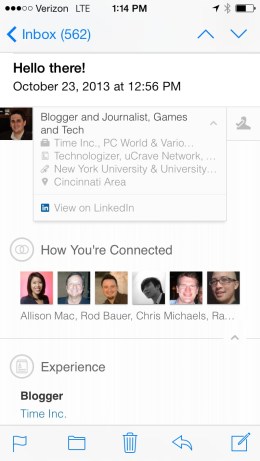
Several years ago, I used and enjoyed a Gmail plug-in service called Rapportive. It added a panel inside Gmail which provided details about the people who sent you messages — a really handy thing to have, especially for folks like me who get scads of mail from folks we don’t know personally.
Then Gmail introduced a preview pane which — temporarily, at least — broke Rapportive. I stopped using Rapportive and sort of forgot about it. And then I attended an event this morning at which LinkedIn announced a lot of new stuff for mobile devices. One of them was a new service called Intro which is essentially an iPhone-friendly, LinkedIn-centric version of Rapportive, which LinkedIn bought in 2012.
Intro works inside Apple‘s own Mail app, which is news in itself, since iOS is famous for not offering the sort of hooks that a service like Rapportive would need to customize one of the default iPhone programs. But LinkedIn didn’t have to work with Apple to make Intro happen — and the iPhone’s Mail app doesn’t even know it’s being enhanced by Intro.
What happens is that the Intro setup process creates a new iPhone e-mail account that sits in betwen your real account and Mail. It serves as a middleman, routing incoming and outgoing messages as if it weren’t there — except for the fact that it enhances the incoming ones with information from LinkedIn. The setup process (which you can start here) is surprisingly simple.
Once you’ve set up Intro, the top of each message you read in Mail sports a small, expandable pane of information about the sender, drawn from LinkedIn: his or her photo, work experience and other background details, updates that person has posted on LinkedIn and a list of people you know in common. Intro sticks it there by embedding HTML code inside the message, but it’s beautifully, seamlessly done. I noticed a few quirks — my own information, for instance, doesn’t include my photo even though I’ve uploaded one to LinkedIn — but for the most part, Intro looks like something that Apple might have built into Mail itself. (The service also creates a signature for your outgoing messages based on your LinkedIn profile, a feature you can turn off.)
This is all assuming that the person who’s e-mailed you is on LinkedIn. If he or she isn’t, the message goes unmodified. LinkedIn is the single best source of the sort of contact info which Intro needs, but I still think it would be cool if it plucked stuff from other sources, such as Facebook and Twitter. Perhaps a future version will.
Intro is super-clever and eminently useful, but some people are going to have a problem with the basic concept, since it requires LinkedIn having access to your e-mail. (The service’s Pledge of Privacy details what it does and doesn’t do with that privilege.) Worst-case scenario, this could be problematic: LinkedIn might suffer a security breach or make ill-advised decisions about what sort of stuff it should be injecting into messages.
Me, I’m no more bugged by this prospect than I am by the fact that using any form of e-mail involves entrusting third-party companies to route my correspondence around. Still, I’m not going to argue that skeptics are being unreasonable. After all, everyone’s in charge of their own comfort level when it comes to stuff like this.
In the end, as with many services which cause any controversy at all, Intro should be O.K.: People who find it appealing and trust LinkedIn will use it, and those who don’t see the point and/or are wary of the company will not. I won’t be a day-to-day user myself, since I do most of my e-mail in Google‘s own Gmail apps for iPhone and iPad. But I give LinkedIn credit for the ingenuity on display in this service — and if it comes to Google’s iOS apps, I’ll be first in line to sign up for it.


